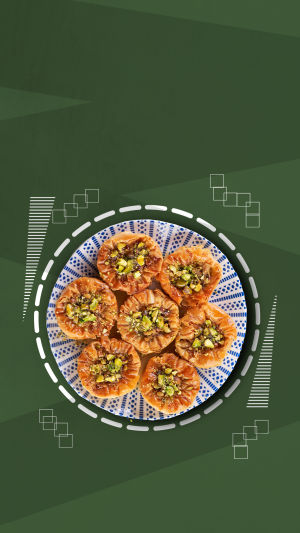The Arabic diet is defined as the diets of various regions across the Arab world, from the Maghreb to the Fertile Crescent and the Arabian Peninsula.
Arabia is not a food desert but has a long history of cuisine spanning hundreds of years. The Arabian region is an important part of the ancient trade routes.
The history of Arabian food can be traced back to the ancient civilizations of the Middle East.
The Sumerians, Babylonians, Phoenicians, Canaanites, Hittites, Assyrians, Egyptians, and Nabataeans all contributed to the formation of the Arabian diet.
1. Baklava
Baklava is the most famous and widely distributed dessert in the Arabian region, with a long history. Baklava is made from phyllo dough, chopped nuts, butter, and sugar or honey as a sweetener. After baking, a deliciously sweet syrup is poured over the layers of the dough.
There are no clear records about the origin of baklava. Both the Greeks and the Turks claim that the origin of baklava is in their country. Other claims point to the placenta cake in ancient Rome, the traditional Turkic layered bread in Central Asia, and Persian Laujina (lauzinaj), among others.
Baklava has continuously evolved, and different regions have their unique methods. For example, in Cyprus, baklava is made into triangular pieces and sprinkled with chopped pistachios. Armenian baklava is made with cinnamon and cloves. In Azerbaijan, baklava is mostly prepared during the Nowruz festival, cut into diamond shapes, and decorated with almonds or walnuts.
In Greece, baklava is made of 33 layers of dough, referring to the 33 years of Christ's life. In the Lebanese city of Tripoli, baklava is made of mille-feuille dough filled with various nuts and soaked in "Atir" (ka-tr) syrup made from orange blossom and rose water, sugar, and water. It is made into various shapes such as triangles and rectangles.
2. Fried sugar balls
Luqaimat can be translated as "bite-sized" in Arabic. Crispy on the outside and soft on the inside, it is the most popular food during Ramadan in Arab countries. Fried sugar balls are the earliest pastries mentioned by scholars in ancient Greek literature.
The ancient Greek poet Callimachus called them "honey tokens" in "The Night Watchman." These desserts were also prizes for the winners of the Olympic Games at that time. The earliest recorded records of fritters date back to the early Middle Ages and the Abbasid Caliphate in the 13th century.
The traditional method of fried sugar balls is made of flour, water, and yeast, fried in a pan, and finally topped with syrup and sprinkled with cinnamon and other spices. In the Arab countries of the Persian Gulf, it is sometimes flavored with cardamom or saffron, which has changed little from the 13th-century recipe.
In Cyprus, the honey syrup is usually flavored with cinnamon and finished with a light dusting of powdered sugar. Greeks flavor it with honey, cinnamon, walnuts, or chocolate sauce. In Türkiye, there are more variations.
3. Kunafa
Known as the "Queen of Arabian Desserts," Kunafa is made of vermicelli-shaped noodles soaked in syrup, topped with soft cheese, and drizzled with rose water and pistachios. First mentioned in written form in the 10th century, it is said to have originated in the Fatimid dynasty of Egypt, and another theory says it originated in the Umayyad period. Likewise, recipes for dishes are mentioned.
Different forms of kunafa have been developed in many cities throughout the Arab region, such as Palestine, Türkiye, and Azerbaijan, each with its own unique recipe. However, the main ingredients remain cheese, nuts, syrup, and wheat. Currently, there are four main types of kunafa:
• Khishnah: A shell made from long, thin noodle strands.
• Na'ama: Semolina dough.
• Mhayara: A mixture of khishnah and na'ama.
• Mbrwma: Prepared with noodles.
This dessert is becoming increasingly popular in other countries and regions outside of the Middle East, and frozen instant versions of kunafa are now available worldwide.





